We Define Gyroplane Training Courses
We have spent more than four years studying gyroplane training courses created in different countries.
We examine and analyse gyroplane incidents and accidents that occur, and learn lessons from them.
Fact: It is not good enough just to teach someone to fly. Flying is a lifetime of learning.
In addition to initial training courses for pilots and instructors, we have defined processes for continuous personal development of knowledge and skills.
We define the courses, our courses are delivered by Instructors and Flying Schools around the world.
- All the courses can be cross referenced to existing regulation in each country.
- Countries who are developing (or re-developing) regulation for gyroplanes can opt to use our courses and standards, saving significant effort.
- Manufacturers and Flying Schools and Gyroplane Organisations can brand our courses as the basis for their own certification awards.
Student Pilot - Pilot Licence Training Course

The Pilot Licence Training Course is a list of lessons that cover all the essential elements of learning to fly a gyroplane to a competent and safe standard.
- For people who have no prior knowledge of aviation - it is a complete step by step guide to becoming a gyroplane pilot.
- For existing pilots who are converting to gyroplanes - it highlights the differences between gyroplanes and other form of aircraft.
We have examined the gyroplane training syllabuses that have been created around the world, to learn from the experience of the pioneer instructors who developed them, and we have consolidated the best practice techniques from these syllabusses into a single list of lessons, applicable worldwide.
After all, the gyroplanes does not know the country in which it is flying, or the nationality of the pilot at the controls
We call this consolidated list of lessons the International Standard Lesson Structure.
The International Standard Lesson Structure provides a consistent framework for organising our training material, our definitions of best practice, and our training courses.
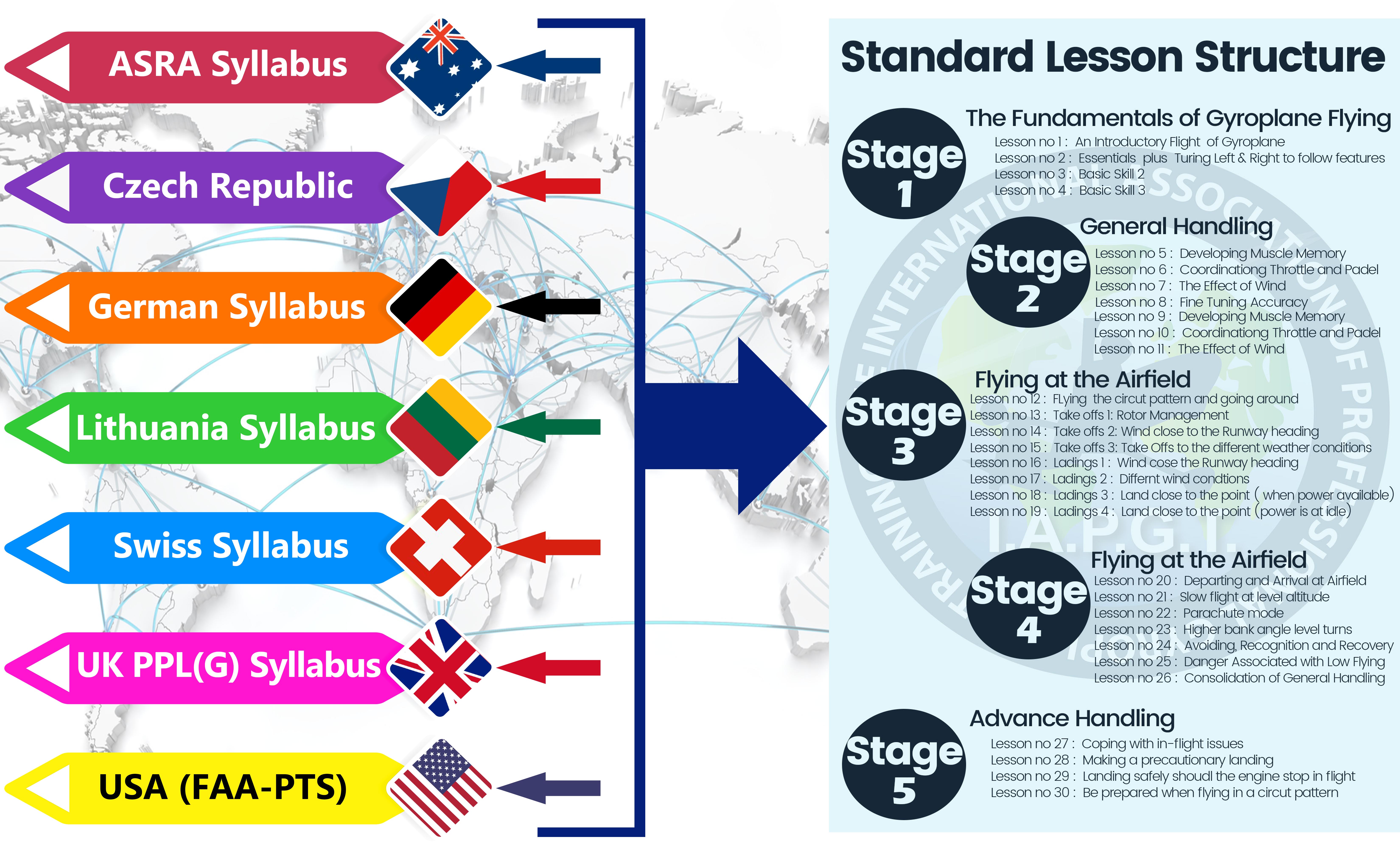
The International Standard Lesson Structure is fully cross referenced to the training syllabusses used in countries around the world.
- All the benefits of the consolidated training material, the best practice knowledge and the instructor training course now automatically supplement existing training syllabus and regulation worldwide without any extra effort by the team involved in a country's gyroplane regulation.
- If pilot training records and logbooks have been linked to the International Standard Lesson Structure, it is possible to print them using the numbering system required by each country. This will make it significantly easlier to obtain a licence to hire and fly gyroplanes in other countries.
When you register on this website and access the Gyropedia you will be able to view the International Standard Lesson Structure.
Gyroplane Pilot - Continuous Development Process

We know, from experience, that pilots who fly for leisure do not fly as often as they would like - why? Because life simply gets in the way. Despite their best intentions, a leisure pilot will typically fly less than 50 hours per year.
Fact : If you don’t use a skill, it will deteriorate over time. Left unattended, the risk of the pilot being involved in an accident increases significantly, when they do not fly regularly.
- We have defined a continuous development process for qualified gyroplane pilots: It is called the IAPGT Pilot Development Program.
- We have defined a recognized standard for a qualified pilot to work towards: It is called the IAPGT Master Pilot.
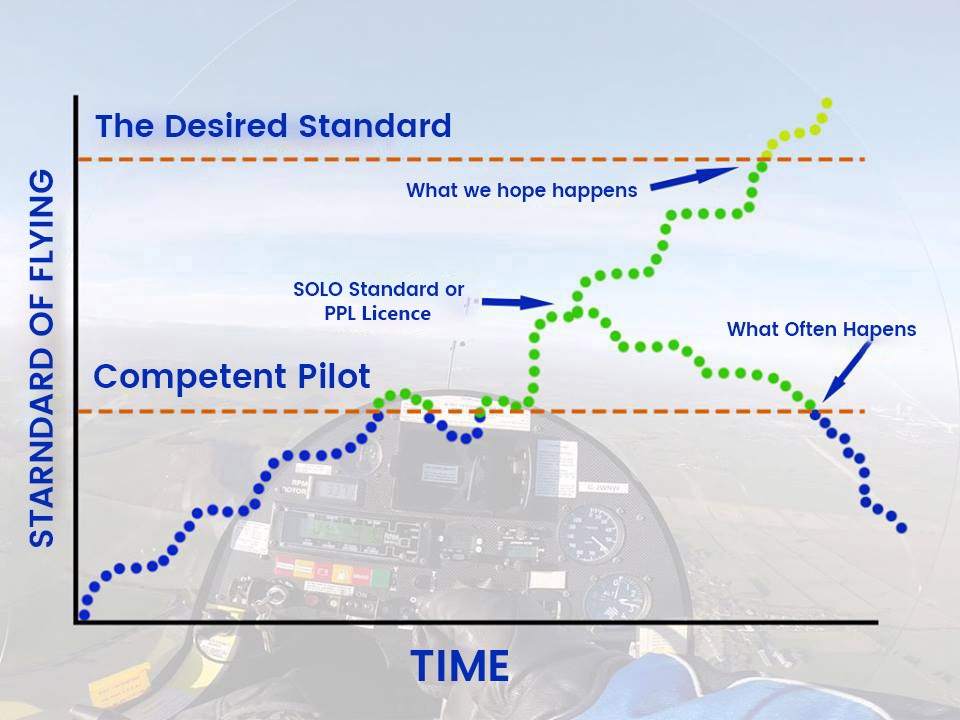
The Pilot Development Program has been designed to improve a gyroplane pilot's flying skill after they have obtained their pilots licence, and keep these skills fresh.
There are three main elements:
- A task and challenge list - to provide a plan for pilots to push themselves.
- Mentoring via flight logging in the Gyropedia
- Skills improvement workshops
We believe that pilots who continually develop their skills not only have fewer accidents but, actually fly more often and get more out of their gyroplane.
The Pilot Development Program is especially suited to qualified pilots who do not live locally to an instructor. It can be facilitated by live web conferencing, with instructors around the world.
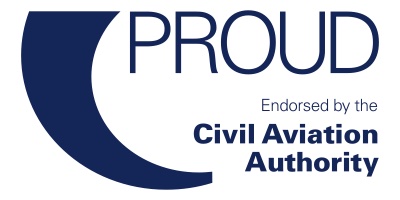
The IAPGT Pilot Development Program is recognised by the UK CAA as part of their PROUD (Pilot Recognition for Operational Up-skilling and Development ) scheme.
Insurance Companies are increasingly interested in the scheme as a postive step to reducing the risk of accidents.
When you register on this website and access the Gyropedia you will be able to participate in the Pilot Development Program.
Trainee Instructor - Instructor Rating Training Course

The IAPGT Instructor Training Course is used to train gyroplane pilots to become gyroplane instructors.
This course is appropriate both for new instructors and existing fixed wing / helicopter / ultralight flying instructors who want to instruct on gyroplanes.
There are two elements to the IAPGT Instructor Training Course.
- The online course helps you prepare for an instructor course in ANY country.
- The practical course includes the flying elements that match the International Standard Lesson Structure.
The IAPGT Online Instructor Training Course
The online course contains:
- Instructional techniques and the core knowledge for becoming a flying instructor.
- A complete set of "train the trainer" videos covering all the lessons in the standard lesson structure
- Key point checklists for each topic that an instructor is likely to explain to their students
- Flight reference cards for the in-flight exercises for each lesson
- The best practice assessment criteria for each element of flying a gyroplane

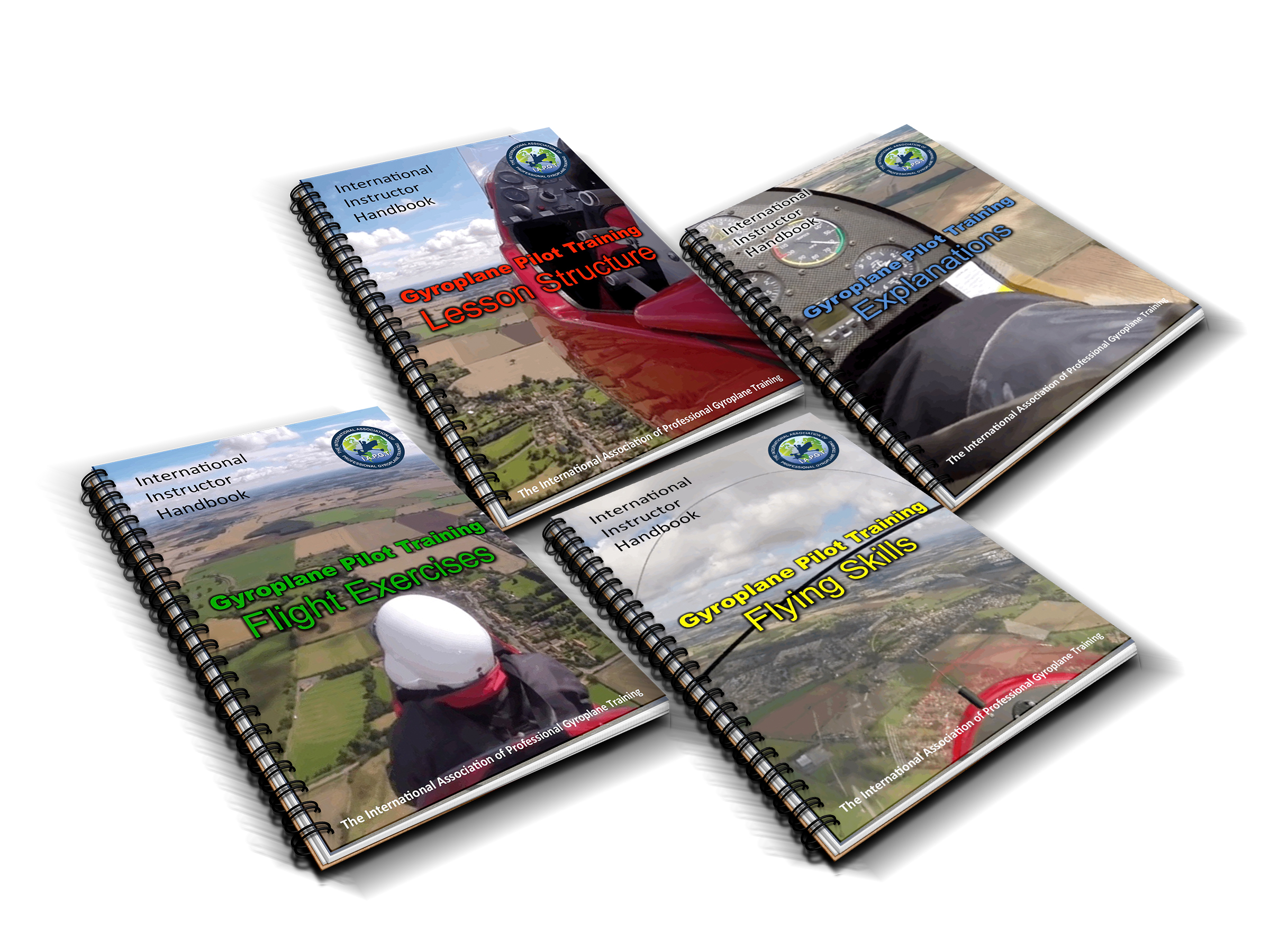
The online course is supplemented with printed reference books, these are handy reference guides that form part of the Instructor Toolkit.
- The International Standard Lesson Structure Definition
- Explanations: Keypoint Checklists, Diagrams and Tools
- Gyroplane Flight Exercises
- Gyroplane Flying Skills - The Best Practice Definition
The Instructor Online Course is available as a 'bolt-on purchase' to standard membership.
The IAPGT Practical Instructor Training Course
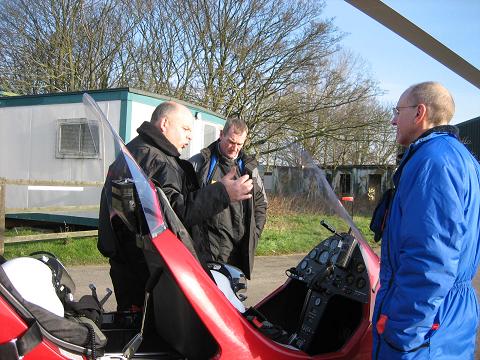
The practical instructor course is a a flying course where a pilot demonstrates their accurate handling capabilities of a gyroplane and an ability to 'teach' the course leader, who is acting as a person learning to fly a gyroplane.
The course contains the following sections
Flown from the pilot's seat
All the elements of the skills test for pilot licence issue, flown to a high standard.
The ability to land in the event of a simulated engine failure from a variety of situations.
Flown from the instructor's seat
Competent take-off and landing as well as flying the circuit pattern with accurate height and speed.
- Precision forced landings - low level and tailwind
- Precision forced landings - low level and above the landing point
- Slow speed precision landings to a soft field
- Hover taxi at the slowest possible sustainable airspeed
- Flying and landing dead stick
- Taking off and landing in strong gusty winds
- Taking off and landing in gyroplane crosswind limits
- Slow rotor rpm build-up with a crosswind
- Slowing down a rotor without the aid of a rotor brake
- General handling errors
- Take-off errors
- Landing errors
- Unusual attitude recovery errors
The flights combine all the lessons of the International Standard Lesson Structure
- The Intial Flights in a Gyroplane
- Building Muscle Memory for Coordination of the Controls
- Basic General Handling
- Rotor Management and Take Offs
- Flying in the Circuit Pattern and Landings
- Advanced Airwork Exercises
- Emergencies
- Pre-Flight Planning and the Skills Test
Demonstration of knowledge and teaching/coaching ability of the following topics
- Aviation Law
- Human Factors
- Gyroplane Technical
- Meteorology
- Flight Planning and Navigation
Demonstration of knowledge of the following topics
- Human Learning
- Progress Reporting
- Systematic Approach to Flying (Threats and Errors)
The examiner is usually appointed by the regulator in the country in which the training is taking place.
How long does the course take?
- The course is competency based, there is no fixed timescale.
- The course has 10 modules and each module can be completed in a day.
- Not participating in the Pilot Development Course in advance typically adds 5 days to the practical training course.
- Not studying the online training course in advance typically adds 10 days to the practical training course.
Pilots who have actively participated in the Pilot Development Course whilst they are building flying hour experience, and they have studied the online training course thoroughly in advance have successfully completed the practical course in only 10 days.
Where can you do this course?
- The course can be taken in any country where there is an instructor certified by IAPGT to deliver the course.
- If you are a pilot and wish to take the course please contact us and advise us of your preferred country.
- If you are an instructor and would like to deliver this course please contact us.
When you register on this website, you will be able to preview the online instructor training material.
Gyroplane Instructor - International Development Process

More and more manufacturers, insurers and gyroplane organisations are keen to recognize instructors who train to a common international standard.
- We have defined a process for inviting all instructors to callaborate on standardisation - the "Best Practice Challenge"
- We have created an Instructor Leadership Masterclass, a training course for qualified gyroplane instructors to gain recognition that they are teaching to the common international standard.
What is involved in standardisation?
Standardisation is simply about having a common way of doing something, in our case - how to fly a gyroplane.
There are different techniques to do things like take-offs, landings, pre-flight planning etc. Standardisation, in our view, is about selecting the techniques that will provide the greatest margin for safety for the pilot who will fly less than 50 hours per year.
The techniques selected are not always the most efficient, or the fanciest, but they will be easy to learn, effective and if an inexperienced pilot does not get it completely correct there should still be the widest safety margin for error.
There are ten elements in our standardisation process:
- The definition of the skills to be taught
- The systematic approach to flying
- The structure of the lessons
- Explanations of gyroplane specific topics
- The content of in-flight exercises
- The debrief technique
- The recording of a student's progress
- Teaching the theoretical subjects
- The general assessment flight content
- Ongoing Pilot development

The Gyroplane Instructor - International Development Process is about Learning the current techniques that have been proposed, Challenging them if there are better techniques and Developing the world standard of gyroplane training.
How do instructors get involved?

There are many different options to help an instructor adopt the process:
- An introduction to all the standardisation element are contained in the book One World - One Standard - One Gyroplane Licence. The content of this book is available electronically in the Gyropedia as part of the free membership option.
- Adoption of the process happens automatically when instructors start to use the free tools for recording student training records in the Gyropedia.
- The training material that is designed for students, included as part of the annual subscription membership option, contains the majority of the explanations of common student questions.
- Instructors can request a Skype 1-to-1 session to understand the process from another instructor.
- Instructors can attend a webinar session.
- Instructors can attend a Best Practice Symposium for Instructors
- Instructors can 'bolt-on' the Online Training Course that has been designed for new instructors. This provides a toolkit of template diagrams, powerpoint style presentations and keypoint checklists
- Instructors can participate in an IAPGT Instructor Leadership Masterclass.
The Instructor Leadership Masterclass
The Leadership Masterclass is a subset of the Practical Instructor Training Course for new gyroplane instructors.
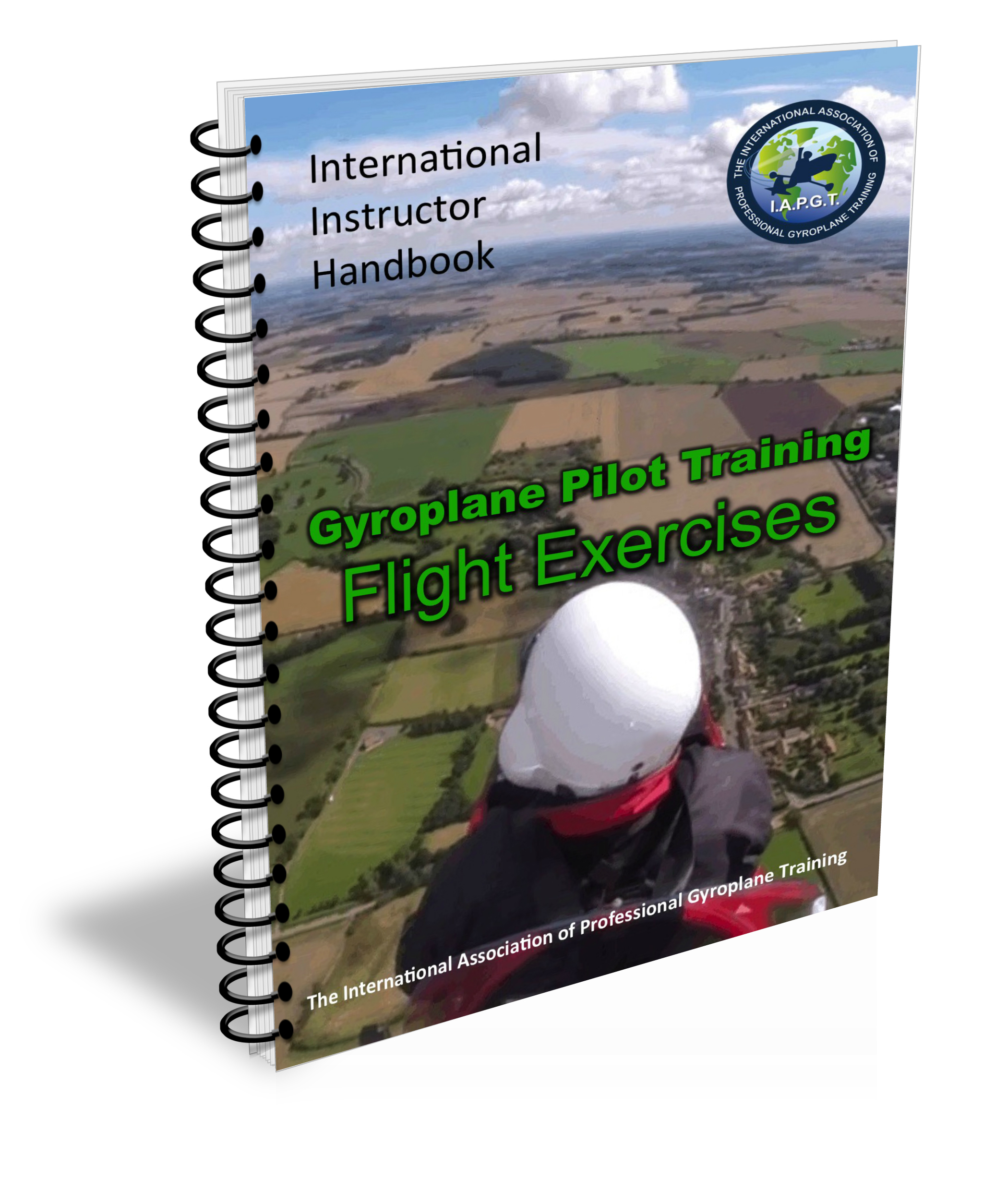
The course helps instructor understand how to use the tools, the checklists and the lesson plans in order to streamline their training and help their student progress as quickly as possible with the limited time often available for training.
The course highlights the different techniques that have been development specifically for gyroplane training that are different from traditional fixed-wing training techniques.
The course involves flying some of the exercises in order to put into context what has been learned from ground-based explanations.
The course typically lasts 5 days. It is designed for small groups of existing gyroplane instructors. The course is most effective when the instructors already have a familiarisation with the training material either through self-study or by attending symposium or webinar events.
Where can you do this course?
- The course can be taken in any country where there is an instructor certified by IAPGT to deliver the course.
- If you are a pilot and wish to take the course please contact us and advise us of your preferred country.
- If you are an instructor and would like to deliver this course please contact us.
We define other courses for specific topics
We have defined other courses relating to gyroplane flying. We have defined the UK CPL(G) Training Course, the UK Night Flying Training Course and an advanced flyng course.
We can help countries define or re-define their gyroplane regulation. We have been involved with regulation for many years and a lot of this effort can be re-used.